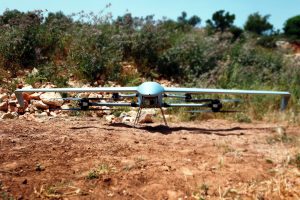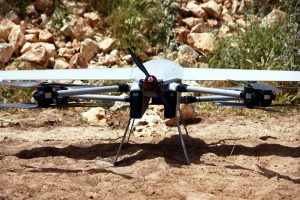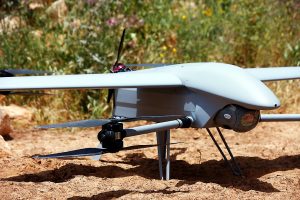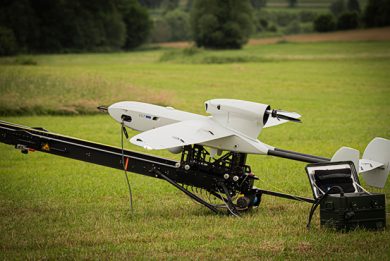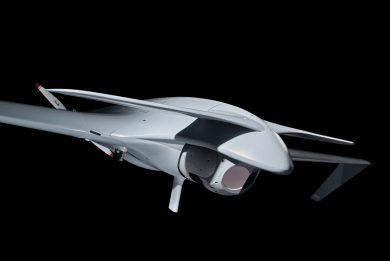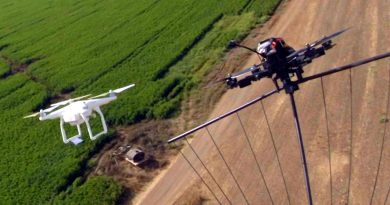
Aeronautics introduces a new category of UAS: the Unmanned Hover Plane
In recent times many unmanned airframes capable to take-off and land vertically while carrying out their mission in airplane mode, the lift being provided by their wings appeared on the market. For most, if not all, of them the hovering phase was limited to the launch and recovery phase, which allowed their operators to avoid the limitations imposed by runways, catapults, parachute or nets.
Aeronautics of Israel, which in fall 2019 became part of the Rafael group [1] while maintaining its independency, is launching at Eurosatory a new concept of hybrid UAS, the UHP, for Unmanned Hover Plane; the difference between the concept developed by the company headquartered in Yafna, some 25 km south of Tel Aviv, and the other hybrid UAS, is that a UHP can fully exploit its rotors also for hovering a number of times for limited periods to carry out its operational mission.
Named Trojan, this UAS has therefore a quite different mission profile. “It is designed to land a lot, it will land behind enemy lines, then take-off again, doing this many times, and can also hover for limited periods to allow full view for example of urban canyons, where loitering UAVs can provide a direct view into an alley for a very limited time,” Matan Perry, Chief Marketing Officer and Vice President Sales at Aeronautics tells EDR On-Line, also pointing out that the idea for developing such a product came from discussions with end-users. “We are not a customer-centric company, we are an end user-centric company,” he adds, being himself a retired Israeli Air Force officer who flew UAS.
The Trojan features eight rotors, coupled two by two and powered by electric motors; the counter-rotating couples of rotors are located at the tip of four struts mounted in an X-shape, the two turned forward fixed at the lower part of the fuselage, while the two looking backwards are mounted in a higher position. A two-blade pushing propeller is installed at the rear, also driven by an electric motor.
The Trojan has a MTOW of 45 kg with a 12 kg payload, and features a high wing with a 4.2 meters span with downwards winglets. “We started flying with winglets turned upwards, then during the development phase we realised that putting them downwards gave us some advantages in terms of stability, however we keep the option open. With winglets down the stand-off from ground when landing is lesser, therefore it depends much on the mission scenario, and this is why we let the customer choose the configuration, although we advice on having them downwards,” Matan Perry says.
The Trojan features a four-leg fixed landing gear. Considering the relatively low maximum flight speed, 25 m/s which is 90 km/h, drag reduction obtained with a retractable gear was evaluated versus its cost, complexity, weight and power consumption, especially considering the numerous landing and take-off operations the Trojan has been designed for. In the end the fixed landing gear solution was considered the best option. To ensure safe landing Aeronautics developed a system capable to select the landing area; this has been considerably improved since the beginning of the Trojan development, no more details being provided as the system has not yet been patented. EDR On-Line understood this is based on on-board sensors with strong algorithms allowing to analyse ground characteristics.
Along the development path, winglets were not the only main changing; in fact at a certain point Aeronautics decided to scale up the airframe, in order to increase the payload. The 12 kg payload allows some flexibility, also thanks to the continuous miniaturisation of payload packages. The optronic gimballed payload is installed at the front of the fuselage, usually fitted with day/night channels, its weight being less than 6 kg other types of payload can be installed up to the maximum acceptable weight. We must not forget that Aeronautics is a group with a number of subsidiaries, such as Commtact specialised in data-links and Controp that is a key player in electro-optics and is owned by Rafael and Aeronautics. Moreover Aeronatics also owns Zanzottera, the Italy-based company that produces engines specially designed for UAVs, therefore it can develop its products counting on in-house key subsystems, controlling the whole product.
According to data provided by Aeronautics, on-board batteries allow a 2.5 hours flight time, considering a standard mission, range being estimated at 150 km. Assuming the aircraft does not fly always at maximum speed, a safe assumption sees a standard mission profile having it operating for around 30 minutes with rotor lift and the remaining two hours on wings lift. The range of the encrypted data link is 40 km. To extend the Trojan endurance is integrating solar panels into the wings. “This will for example allow the Trojan to land in an elevate position, putting its sensors on the area to be monitored, and while it is on the ground batteries are being recharged. This is something we are developing and is not yet operational,” Matan Perry underlines.
According to Aeronautics, the Trojan is very easy to fly, the company having always stressed this approach as the users of its products will be soldiers, not pilots, therefore the whole system must remain simple. “We are developing easy-to-fly UAS, in order to reduce as much as possible training. Our aim is to have the soldier looking 98% of the time at the screen where the images provided by sensors are shown, reducing to a minimum the time spent to check flight data,” he states. EDR On-Line understood that the operator can switch the Trojan in hovering mode while bringing it back to wing-sustained flight at the push of a button.
The Trojan configuration is now fully frozen, the product being ready for production and is considered at TRL 8.
Looking ahead, considering new technologies, Mr. Perry underlines the importance of being part of the Rafael family, which gives Aeronautics an almost unlimited access to new technologies that might be included in company products, such as sensors, navigation and computing systems, which will allow Aeronautics offering superior systems to its customers. Asked about Artificial Intelligence, he pointed out that Rafael and Stolero Group, the two owners of Aeronautics, created a new company, SightX AI, which is specialised in AI developments for defence, and visiting its website shows well how much that company cannot say. Having a sister company specialised in AI will certainly be beneficial for further developments, as these new technologies are becoming of increasing importance in all fields. The same applies to the aforementioned Aeronautics group subsidiaries, as having within the same group the producers of all key components allows to have a common view on the future, coordinating developing roadmaps and investments to answer future needs.
Aeronautics R&D engineers are already thinking at the next version of the Trojan, or possibly at the next UHP, while the company is celebrating its 25th anniversary launching its new UHP concept and its new Trojan product at Eurosatory.
Photos courtesy Aeronautics
[1] Aeronautics shares were acquired 50% by Rafael Advanced Defense Systems Ltd and 50% by Mr. Avichay Stolero

